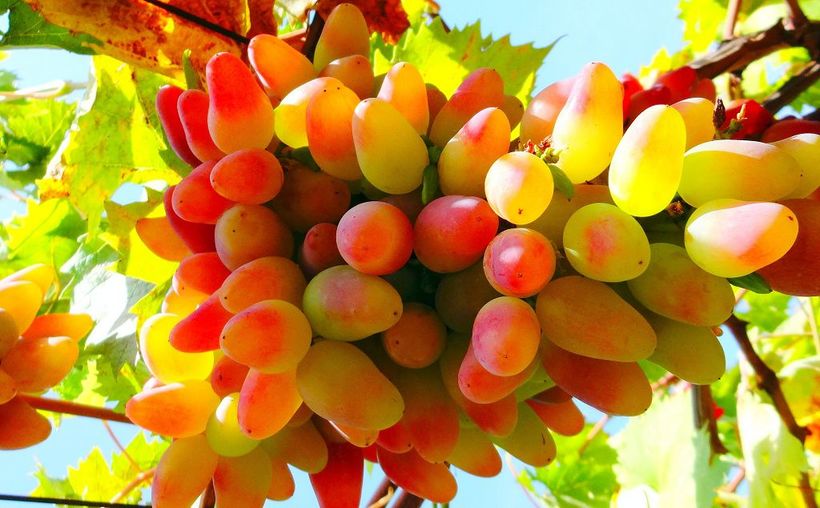
The history of the appearance of ladies' fingers is centuries old. In 1613, the vine was brought to Astrakhan and Crimea from Asian countries, but it is not known for certain how this species was bred. There is speculation that this was a long journey of reusable selection of wild grape seeds.
In the east, it is called Husayn white, in Russia it has the name Bokalny. Ladies' fingers mature only in a warm climate, in the southern regions of the country. To make the berries sweet and tasty, they need light, warmth and moderate humidity.
Content
Characteristics of the Glass
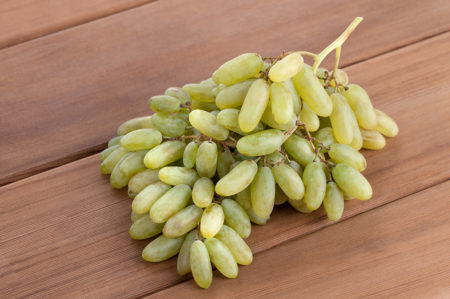
The Vocal Grape Vine is vigorous. Flowers appear of both sexes, are well pollinated. The leaves are three-lobed and five-lobed, round. On the sheets below there is a small bristle, their edges are raised. Notch petiole open, stalk brittle.
Clusters in the form of a cone. The weight of one brush is from 400 g to 1 kg. The length of the bunch is 20-60 cm, in breadth the size is 15-25 cm.
The vegetative period of the variety is 130-140 days. The first fruits appear after 4 years of life. To increase the ripening of the berries, the vine is cut into 8-10 eyes.
Description of berries:
- size - large, 24-35 mm by 15-25 mm;
- shape - conical, elongated;
- berry mass - 5 g;
- color - light green with yellowness;
- peel - strong, thin;
- the bones are elongated, brown in color, practically absent;
- the flesh is juicy, sweet, with a crunch.
Sweet berry has a slight acidity. Sugar contains 16-18%, acid 4 g / l. The growth rate, the presence of bisexual inflorescences, certain growing conditions yield up to 35-40 tons of berries per hectare. Rains or dry summers significantly reduce the amount of yield. Grape harvest takes place in September.
Use Lady's fingers for the production of white wines, high-quality raisins and simply eat fresh.
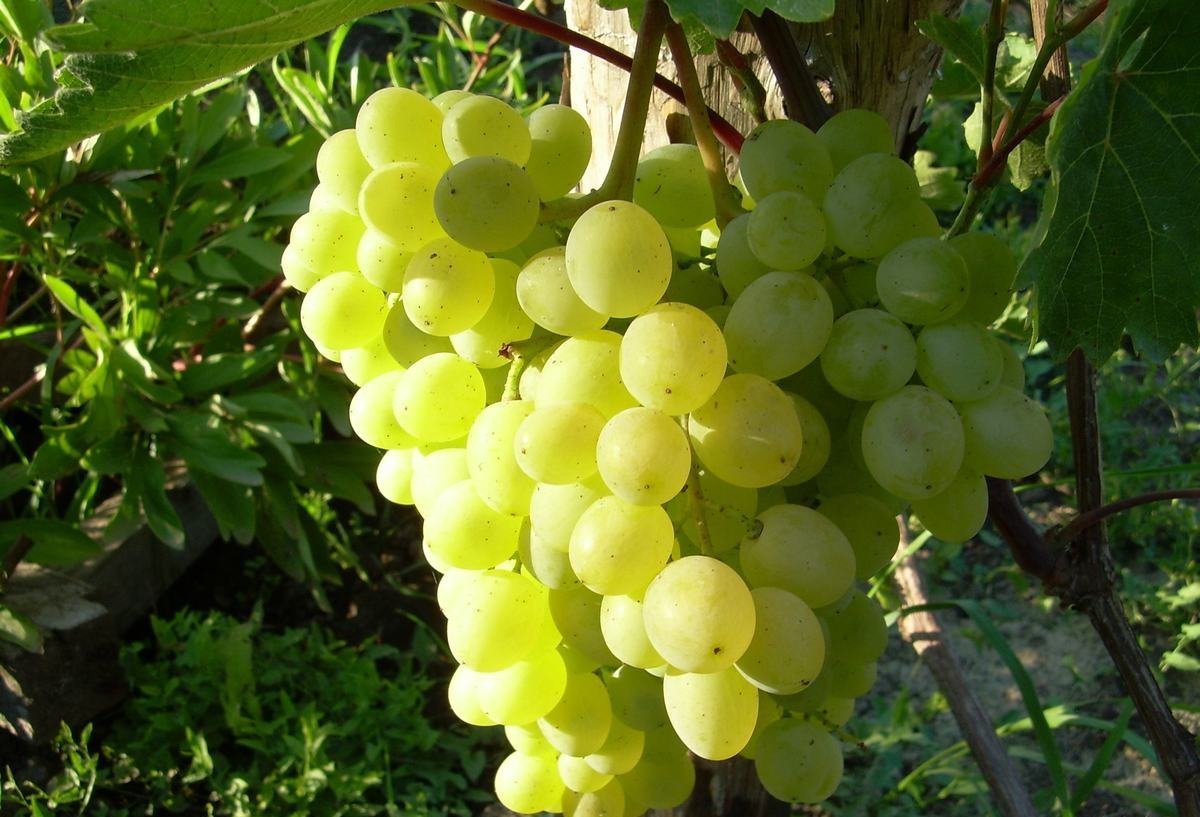
Alex grapes: characteristics and description of the variety, planting and care
Especially for gardeners living in harsher climates, a grape variety called ...
Grade Advantages
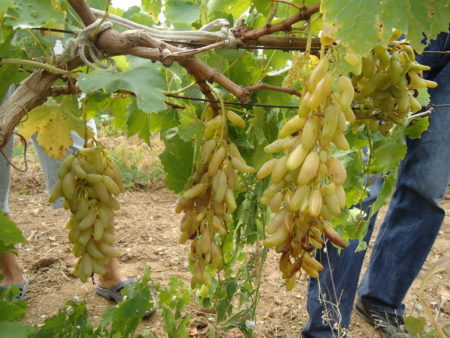
Glass grapes have many healing qualities. The vitamin complex and mineral salts that make up the berries are necessary for the development and growth of the young body. Grapes strengthens the immune system, helps with coughing, improves digestion, favorably affects the work of the heart system, and prevents oncological formations.
Advantages of Ladies Fingers:
- excellent taste of berries;
- high yields;
- high-quality clusters;
- does not require additional pollination, thanks to the colors of different sexes;
- thanks to a strong skin, easily transfers transportation;
- long brushes on the vine;
- possesses healing properties;
- external aesthetic appearance;
- obtained from grapes high-quality raisins.
Variety disadvantages
Despite the advantages and productivity, the Ladies' finger has drawbacks. Temperature extremes, rain, drought all affect the harvest. Cons of Glass of Grapes:
- it is not resistant to low temperatures; in winter, when the temperature drops to -10 C *, the vine may die;
- often affected by various fungi, they develop in hot or rainy weather;
- high humidity can lead to rotting berries;
- exacting to care.
Pollination
The main condition for high-quality pollination is the abundance of sunlight.Those inflorescences that have been in the shade for a long time may not be pollinated at all; there is shedding of flowers or ovaries.
At low temperatures (below 14 degrees) and high above 30 degrees, the pollination process slows down. At 35 degrees, the liquid on the stigma of the pestle dries, the pollen does not stick to it, the ovary does not form.
During rain, the transfer of pollen is difficult, and water can simply wash it off. It helps to pollinate the inflorescence wind, but not strong. Pollen easily falls on a neighboring flower, forming an ovary.
Husayn grapes have flowers on one cluster of both sexes. Bees, bumblebees, flower flies, moving on flowers, carry nectar and pollen on their paws. If there are not enough insects, then winemakers set sweet traps between the bushes. Grape flowers are not sweet, and do not have enough flavor to interest bees.
In the inflorescence can be up to 1300 flowers. If each of them were pollinated, then the clusters would not withstand the heaviness of the berries, break off before ripening. To improve the quality of pollination, two rows of ladies' finger bushes and a third row of pollinator cultivar are planted. This scheme helps to increase the yield of grapes.
Diseases and Pests
If the vine bushes do not feel comfortable - the climate is not suitable, limited watering or high humidity, then the disease will quickly spread to the vine bushes.
Diseases
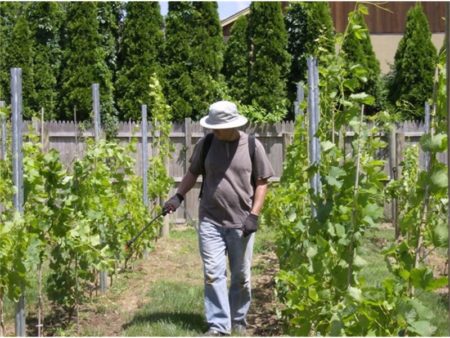
In the rainy season, grapes must be protected from fungal diseases. Time to remove rotting berries, infected leaves, make sure that the fungus does not spread to neighboring plants.
Fungal disease:
- oidium - the fungus has the smell of decaying fish;
- powdery mildew - a characteristic gray coating on the leaves;
- mildea - yellow spots are present on all parts of the plant, after rain they become white.
Measures to combat fungal infections:
- pruning of infected branches in autumn;
- Do not plant bushes in the lowlands;
- comply with the ventilation conditions;
- treat plants and soil with copper sulfate;
- during the growing season, use Bordeaux liquid;
- feed plants with potassium, phosphorus and mineral additives;
- apply drugs: Fundazol, Efal, Belitol, Mikal, Stroviy, Sandofan and others.
Harmful insects
Grapevine love to visit leaflet, phylloxera, cicada, ticks, thrips, grape aphid, weevil. Wasps eat up the sweet flesh of berries, thereby causing enormous damage to the grapes. Birds peck ripe berries, damaging the brush.
Pest Control:
- They make sweet traps for wasps: jars, bottles with sugar or honey water.
- Birds are held by metal nets over bushes, rattles, spinning mirror balls, stretched ropes or threads.
- It is necessary to destroy the weed grass, loosen the soil, dig the site.
- It is necessary to get rid of dry bark, burn it.
- Remove diseased plants from the site and burn them.
- After the appearance of phylloxera, the vine cannot be planted in the same place for more than 15 years.
- To process grape plants with Actellik, Fufanon, Aktara, Alatar. The drugs are effective against aphids, ticks, thrips, leaflets, weevil.
- Cicadas and phylloxera are destroyed by drugs Confidor, Arrivo, Karate, Kinmiks.
- The means scattered between the rows of Muhoed, Bazudin, Zemlin will help from scoops and Khrushch.
Many pests can be scared away by garlic tincture (for 5 l of water, 100 g of garlic) or a decoction of onion husks. It is enough to process bushes with these means twice a month.
Agricultural technology varieties
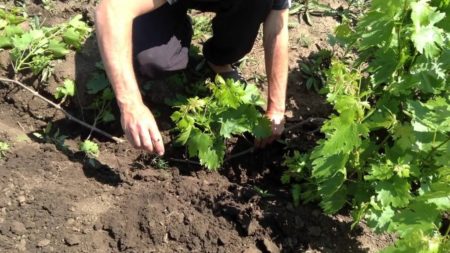
Ladies' fingers prefer sunny terrain, without drafts. Better if it is the southern slope. The depth of groundwater should be 3-3.5 meters.
Landing
Grape seedlings are planted in the fall. If the bushes are planted in the spring this is done before the buds open.The soil for planting cuttings should be heated more than 10 degrees.
For landing, you need:
- pit depth up to 1 meter and a width of 80 cm;
- landing scheme 3 m to 5 m;
- the third part of the well is filled with organic fertilizers or compost, superphosphate and potassium are added;
- pour sand and gravel into the pit;
- lime is added to the soil with increased acidity (per square 150 g).
Saplings are kept for 24 hours in a biohumus solution before being transferred to the plot. A tubercle is made in the pit, the roots of the plant are placed on it. Sprinkle with earth to the root neck, compact the soil, watered with 3 buckets of water and mulch the surface. A peg is driven in near the seedling, a plant is tied to it.
In addition to cuttings, air layers are used for planting, instillation of shoots, propagation by root shoots.
Care
Pruning and vine garter, timely watering, proper top dressing, preparation for winter - the main conditions for growing quality grapes.
Trimming and shaping bushes
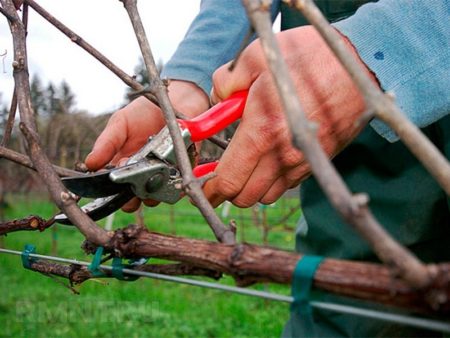
For pruning, choose sick, old or damaged shoots. Left processes must be ripe, medium size up to 10 mm in diameter. Too thick branches break quickly.
Equipment and conditions for pruning bushes:
- sharp pruning shears for a clean and even cut;
- cut old branches at a right angle and further from the base;
- young lashes are cut under the lower eye, leave up to 3 cm in length;
- cut branches make cuts into the bush;
- leave only strong and healthy shoots;
- if possible, the cut site is treated.
For Bokalny grapes, long pruning is recommended. It is cut for 9-12 eyes, and stepsons for 5-10 eyes.
Garter
If the gardener does not provide support for the grapes, then the liana will find it for herself, because she curls and spreads. Proper garter protects the bushes from fungal infection. Tying gives access to light and airing the vines.
Last spring they tie up shoots with sleeping buds. Before garter, the lashes are cut off. Branches are attached to a trellis or net. The distance between the two posts is about 3 m. Ropes or wire are stretched between them. The first is at a height of 40-45 cm from the ground, the subsequent ones are tied at the same distance from each other. Perennial branches fix fan at an angle of 50-60 degrees with an arc or horizontally.
Young branches are tied up on 3-4 tiers. Horizontal tying helps to avoid breaking during the wind.
Watering
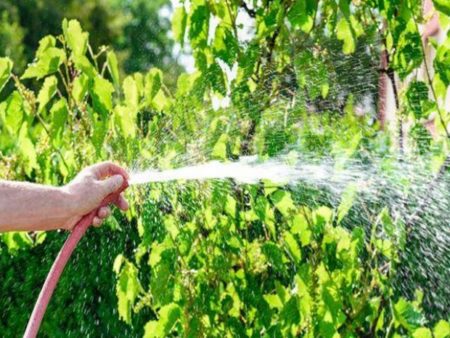
In the summer, in heat, about 1.5 liters of liquid evaporates from one square of the earth. Without water, the berries grow smaller, the leaves dry, the vine wilts. Rhizome grows intensively in search of moisture. The forces of the plant are spent not on the formation of the brush, but on the growth of the roots. Neighboring plants suffer from the roots.
Remove the top layer in the hole so that the water does not go beyond it. One plant takes from 5 l to 10 l of water. Grapes are watered in hot weather once a week in the evening. Complex additives can be added to water. A month later, watered twice a month, in August, watering is stopped so that the brushes are fully ripe.
Be sure to water the plants when the buds open, after flowering, and during the ripening of the berries. When buds are formed and during flowering, irrigation is stopped so that the flowers do not fall off.
Pour water only into the furrows or into the rings around the bushes. It is best to use a drip method of watering. After watering the pits, it is advisable to fall asleep. This will help retain moisture in the soil.
Top dressing
If the earth is not fertilized, it quickly depletes. The grape harvest will deteriorate.
In the spring, nitrogen (urea or nitrate) is introduced at the beginning of the growing season. In August, nitrogen supplements are harmful; foliage will develop instead of brushes.
Phosphate fertilizers are added at the beginning of flowering.Plants are fertilized with potassium in August, during the period of cluster ripening. Copper enhances shoot growth, helps survive frosts. Boric acid increases sugar in berries, stimulates the appearance of pollen. Zinc supplements significantly increase yield.
Sample fertilizer scheme:
- After wintering, add potassium salt 15 g, superphosphate 20 g, saltpeter 10 g per bucket of water. This mixture is poured under one bush.
- Before flowering, feeding is repeated for 2 weeks.
- Before the formation of berries, phosphorus and potassium are used.
- In September, 25 g of potassium and phosphorus per square meter are used.
Every 3 years in the autumn, under digging, cow manure is scattered along with ash, ammonium sulfate, and superphosphate. 1 g of potassium iodine is added to the sandy soil.
Winter preparations
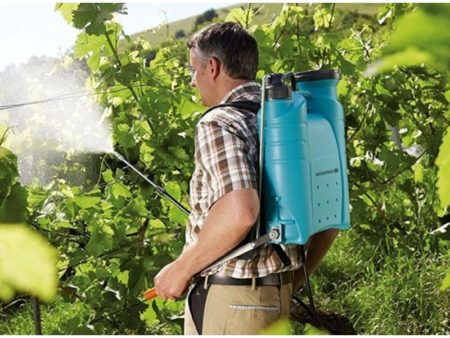
After harvesting the vine and leaves are treated with means containing copper. It will destroy the spores of various fungi. Plants are sprayed with copper sulfate in a bucket of water of 300 g. The leaves are sprayed with a nutrient solution: 10 g of superphosphate, 5 g of kalimagnesia in 9 l of water.
Be sure to prune old and adult branches, leaving a small reserve of buds. Trimmed bushes are easier to shelter, and they better winter.
To cover the grapes Before wintering, they dig trenches between the rows, lay the vine in them, fasten them with brackets and sprinkle with earth 30 cm. The place of powdering is indicated by pegs. Instead of land, you can use a film, straw or a modern covering material: spunbond, roofing material, foam. Around the film they pour earth so that moisture does not get.
Grape storage
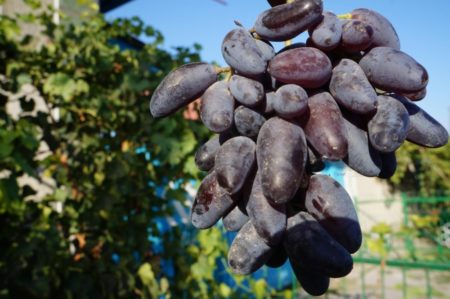
Bunches are collected only in dry, clear weather. Wet berries will begin to rot. They carefully cut the brushes, hold the peduncle so as not to damage the wax coating on the berries. Grapes are placed in boxes, transferred to a dark, cool room. Bright light reduces the amount of sugar in grapes. Keep brushes at a temperature of 0 C * and a humidity of 80%. In a dry and warm place moisture evaporates quickly, the berries dry. It is better to fumigate the room with sulfur (50 g per 1 sq. M), add saltpeter and dry sawdust. In such a room, clusters can tolerate frost up to - 4 degrees.
You can hang the grapes on a wire, it will be aired all the time, infection with the fungus will not occur.
Periodically, you need to review the entire crop, when signs of rot appear, remove infected clusters, otherwise the infection will be large-scale. The remaining brushes in the box must be washed and eaten. Further storage of it is not advisable.
Reviews
Svetlana, 38 years old
When covering grapes with straw, pay attention to the spikelets with grain. If they are present, then the mice will come to feast on them, they can arrange nests near the vine bushes. They will nibble the whole vine. I sprinkled red pepper around the plants, it scares off rodents.
Elena Dmitrievna, 56 years old
She covered the grapes with soil for the winter, after wintering some branches were hit by a fungus, some froze. It is best to cover the vine with film or natural material. After all, spores of fungi can be in the ground, and the earth does not always save from frost.
Nikolai Ivanovich, 62 years old
I have been growing grapes for many years. I have planted 5 different varieties on the plot, among them the Ladies' finger variety. The grapes are tasty and sweet. But it requires constant feeding and watering. Without spraying, it is affected by the fungus.

 Non-covering winter-hardy grape varieties for Moscow region
Non-covering winter-hardy grape varieties for Moscow region How to keep the vine in winter
How to keep the vine in winter When can I transfer grapes to another place in the fall
When can I transfer grapes to another place in the fall How to cover and prepare grapes for the winter in the suburbs
How to cover and prepare grapes for the winter in the suburbs